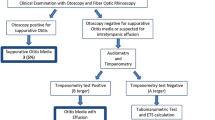Abstract
Human immunodeficiency virus (HIV) affects the vital cells of the immune system eventually leading to a fall in the cell mediated immunity. As the disease progresses CD4 + (cluster of differentiation4) cells reduce, therefore is a good indicator of the ongoing disease process [1]. HIV infection has myriads of disease presentation; the aim of our study was to correlate the otorhinolaryngological manifestations with the CD4 + counts. A clinical study, of 100 HIV positive patients was done from 2008 to 2011. A clinical evaluation revealed 76 % incidence of otorhinolaryngological findings. Oropharyngeal manifestations were the commonest, seen in 48 %, predominantly oropharyngeal candidiasis. Neck nodes were found in 20 % of the patients. 31 % had otological manifestations of which retracted tympanic membrane (eustachian tube dysfunction) was the commonest. 18 % had nasal symptoms of which rhinosinusitis was the commonest being 14 %. The mean CD4 + count was below 200 in patients who presented with oropharyngeal candidiasis, otitis externa and epistaxis. With the use and availability of HAART (Highly active antiretroviral therapy) more and more patients with higher CD4 + count are presenting with a different spectrum of more subtle disease manifestations, with lower incidence of the classical diseases like candidiasis. A routine otorhinolaryngological evaluation at every visit with high index of suspicion can help in better disease control and give a better quality of life.
Similar content being viewed by others
References
Nicholas john Bennett (2013) HIV Disease, web http://www.emedicine.medscape.com/article/211316- overview
A brief history of HIV/AIDS http://www.aegis.com/topics/timeline/
Cunningham A, Donaghy H, Harman A, Kim M, Turville S (2010) Manipulation of dendritic cell function by viruses. Curr Opin Microbiol 13(4):524–529. doi:10.1016/j.mib.2010.06.002
Garg H, Mohl J, Joshi A (2012) HIV-1 induced bystander apoptosis. Viruses 4(11):3020–3043
Kumar, Vinay (2012). Robbins Basic Pathology (9th ed.). p. 147. ISBN 9781455737871
Diseases and disorders. Tarrytown, NY: Marshall Cavendish. 2008. p. 25.ISBN 978-0-7614-7771-6
Mandell, Bennett, Dolan (2010). Chapter 118
Centers for Disease Control and Prevention. (1992) 1993 revised classification system for HIV infection and expanded surveillance case definition for AIDS among adolescents and adults. MMWR Recomm Rep.; 41(RR-17): 1–19
World Health Organization. (2007) WHO Case definitions of HIV for surveillance and revised clinical staging and immunological classification of HIV-related disease in adults and children
Consolidated guidelines on the use of antiretroviral drugs for treating and preventing hiv infection recommendations for a public health approach www.who.int/iris/bitstream/10665/85321/1/9789241505727_eng.pdf
Deb T, Singh NB, Devi HP, Sanasam JC (2003) Head and neck manifestations of HIV infection. A preliminary study. J Indian Med Assoc 101(2):93–525
Kishore Chandra Prasad H, Bhojwani Kiran M, Vijendra Shenoy, Sampath Chandra Prasad (2006) HIV manifestations in otolaryngology. Am J of Otolaryngol 27(3):179–185. doi:10.1016/j.amjoto.2005.09.011
Hadfield PJ, Birchall MA, Novelli V, Bailey CM (1996) ENT manifestations of HIV infection in children. Clin Otolaryngol Allied Sci 21(1):30–36. doi:10.1111/j.1365-2273.1996.tb01021.x
Williams MA (1987) Head & neck findings in pediatric acquired immune deficiency syndrome. Laryngoscope 97(6):713–716. doi:10.1288/00005537-198706000-00013
Sulyman AB, Kazeem SA, Abdulrahman A, David D, Kayode AS, Oluwayemisi O et al (2010) Otolaryngologic manifestations among Hiv/Aids patients in a Nigerian tertiary health institution: an update. Int Arch Otorhinolaryngol 14(4):398–403
Hadderringh RJ, Tange RA, Danner SA, Eeftinck S (1987) Otorhinolaryngological findings in AIDS patients: a study of 63 cases. Eur Arch Otorhinolaryngol 244(1):11–14
Conflict of Interest
None.
Author information
Authors and Affiliations
Corresponding author
Rights and permissions
About this article
Cite this article
Kirti, Y.K., Yashveer, J.K. & Poorey, V.K. Changing Trends of HIV/AIDS in Otorhinolaryngology with CD4 + Count Correlation. Indian J Otolaryngol Head Neck Surg 67 (Suppl 1), 12–15 (2015). https://doi.org/10.1007/s12070-014-0712-8
Received:
Accepted:
Published:
Issue Date:
DOI: https://doi.org/10.1007/s12070-014-0712-8




